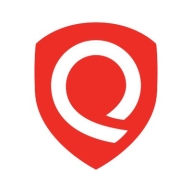


Amazon EKS and Qualys TotalCloud compete in cloud infrastructure and security management. Amazon EKS has the upper hand in user convenience, but Qualys TotalCloud's robust security features make it a preferred choice for comprehensive security needs.
Features: Users value Amazon EKS for seamless Kubernetes deployment, scalability, and strong integration capabilities. Qualys TotalCloud is known for comprehensive security coverage, detailed vulnerability assessments, and network security.
Room for Improvement: Amazon EKS could enhance support for multi-cloud environments, and provide more flexibility and integration options. Qualys TotalCloud needs improvements in ease of use, reduction of complexity, and user interface enhancements.
Ease of Deployment and Customer Service: Amazon EKS receives positive feedback for straightforward deployment and responsive customer support. Qualys TotalCloud's deployment is more complex, but customer service is noted for technical support expertise.
Pricing and ROI: Amazon EKS is praised for straightforward pricing and good ROI, especially for companies invested in AWS. Qualys TotalCloud, while more expensive, justifies its cost with extensive security features.
The detailed information PingSafe gives about how to fix vulnerabilities reduces the time spent on remediation by about 70 to 80 percent.
After implementing SentinelOne, it takes about five to seven minutes.
Our ability to get in and review our vulnerability stance, whether daily, monthly, weekly, or whatever it might be, has drastically improved over our prior provider.
It has saved about 90% of our time.
TotalCloud has generated overall savings of 30 to 40 percent across various departments.
CallStream helps us integrate and automate tasks.
When we send an email, they respond quickly and proactively provide solutions.
They took direct responsibility for the system and could solve queries quickly.
Having a reliable team ready and willing to assist with any issues is essential.
We have a paid subscription that provides priority support.
Amazon's technical support is quite good, especially for those who purchase support services.
Having to know what questions to ask is essential.
They are helpful, respond to my queries, and can answer any question.
Qualys's tech support is highly responsive, providing multiple ways to interact with them.
Qualys' customer service provides quality answers, but the response time is long, even though it is within the SLA.
As soon as we need to add somebody, we just add them to NinjaOne, and then we have a script set up where it automatically deploys and adds them to whichever group we need.
I would rate it a 10 out of 10 for scalability.
Scalability is no longer a concern because Cloud Native Security is a fully cloud-based resource.
The ability to scale based on requirements by deploying additional containers is a strong point for Kubernetes.
It can scale very well according to needs, and it doesn't have any issues with scalability.
I would rate the scalability of Amazon EKS an eight out of ten, suggesting it has high scalability.
We started our organization about nine months back. We started with about 30 users, and we now have more than 100 users.
Our organization currently uses it to manage over 1200 web applications.
It is absolutely scalable, and I would rate its scalability as nine out of ten.
In my experience, there has been 100 percent uptime.
SentinelOne Singularity Cloud is incredibly reliable.
The cloud console is very resilient.
Overall, the support provided has been excellent.
It is a stable solution, which is why we chose it.
Continuous monitoring is crucial to ensure system stability and avoid vulnerabilities or threats.
If I had to ask for anything to make it easier, it would be signed images that are GPG signed and a public repository where we can get the bits from.
If they can merge Kubernetes Security with other modules related to Kubernetes, that would help us to get more modules in the current subscription.
As organizations move to the cloud, a cloud posture management tool that offers complete cloud visibility becomes crucial for maintaining compliance.
Simplifying these will enable more people, not just those with strong foundational knowledge, to work effectively with these services.
A UI could help generate config files, simplifying the process for developers who are not architects.
Currently, some third-party plugins, like certain network plugins such as CNI, Calico CNI, or Cilium, are not fully supported.
Ideally, the scanner should automatically detect and scan all subdomains, even if not explicitly defined, ensuring comprehensive vulnerability assessment.
Ideally, updates should be more immediate, enabling quicker implementation of solutions.
Our goal is to integrate all these functions into Qualys, creating a single dashboard for comprehensive security monitoring and management.
With very little negotiation involved, we just let them know what we could pay and they were willing to meet us at slightly above what we paid with Sophos, which was still very fair for what we were looking at.
The price was very, very important to us, and it came down to the price when we were doing our evaluations WatchGuard and SentinelOne.
Covering our 50,000 endpoints would have nearly bankrupted most security programs, even well-funded ones like ours.
The pricing structure is beneficial for large companies who pay for what they use, but it is not affordable for startups.
Qualys TotalCloud's pricing is currently acceptable, it is becoming increasingly expensive.
Pricing is managed by our finance team; however, Qualys TotalCloud offers cost-effective licensing flexibility.
Qualys TotalCloud is expensive, but it offers a premier solution with no headaches.
The real-time detection and response capabilities of SentinelOne Singularity Cloud impressive because it is a platform that uses artificial intelligence to determine what is normal and what is abnormal and can lock down any virus it may encounter.
We were shown how ransomware can be immediately stopped in real-time. That was huge.
Our previous product took a lot of man hours to manage. Once we got Singularity Cloud Workload Security, it freed up our time to work on other tasks.
The most beneficial aspect of Amazon EKS is that it helps manage the Kubernetes master node, so I don't need to maintain the master node, including tasks like upgrading.
The scalability is excellent, allowing us to efficiently handle customer experiences and improve operational efficiency.
Now, with the serverless option, you can deploy everything and AWS handles the infrastructure.
This view of risk helps reduce the work we would have to do to combine multiple sources to prioritize risk.
It will help cybersecurity professionals monitor the cloud and find vulnerabilities.
We are enjoying the new feature, FlexScan, which is valuable for Internet-facing VMs.



SentinelOne Singularity Cloud Security protects cloud workloads, offering advanced threat detection and automated response. It integrates seamlessly with cloud environments and secures containerized applications and virtual machines against vulnerabilities.
SentinelOne Singularity Cloud Security is renowned for its efficiency in mitigating threats in real-time. The platform integrates effortlessly with existing cloud environments, ensuring robust cloud security management with minimal manual intervention. Securing containerized applications and virtual machines, it excels in threat intelligence and endpoint protection. However, improvements are needed in performance during high workload periods, and more integrations with third-party tools and better documentation would be beneficial. Users often find the installation process complex, support response times slow, and the dashboard's navigation unintuitive.
What are the key features of SentinelOne Singularity Cloud Security?In specific industries, SentinelOne Singularity Cloud Security is implemented to safeguard critical data and infrastructure. Organizations in finance, healthcare, and technology depend on its real-time threat detection and automated response to protect sensitive information. Its ability to secure containerized applications and virtual machines is particularly valuable in dynamic environments where rapid scaling is necessary.
Amazon Elastic Kubernetes Service (Amazon EKS) is a fully managed Kubernetes service. Customers such as Intel, Snap, Intuit, GoDaddy, and Autodesk trust EKS to run their most sensitive and mission critical applications because of its security, reliability, and scalability.
EKS is the best place to run Kubernetes for several reasons. First, you can choose to run your EKS clusters using AWS Fargate, which is serverless compute for containers. Fargate removes the need to provision and manage servers, lets you specify and pay for resources per application, and improves security through application isolation by design. Second, EKS is deeply integrated with services such as Amazon CloudWatch, Auto Scaling Groups, AWS Identity and Access Management (IAM), and Amazon Virtual Private Cloud (VPC), providing you a seamless experience to monitor, scale, and load-balance your applications. Third, EKS integrates with AWS App Mesh and provides a Kubernetes native experience to consume service mesh features and bring rich observability, traffic controls and security features to applications. Additionally, EKS provides a scalable and highly-available control plane that runs across multiple availability zones to eliminate a single point of failure.
EKS runs upstream Kubernetes and is certified Kubernetes conformant so you can leverage all benefits of open source tooling from the community. You can also easily migrate any standard Kubernetes application to EKS without needing to refactor your code.
TotalCloud is the Qualys approach to Cloud Native Application Protection Platform (CNAPP) for cloud infrastructure and SaaS environments. With TotalCloud, customers extend TruRisk insights (transparent cyber risk scoring methodology) from the Qualys Enterprise TruRisk Platform to their cloud environments allowing for a seamless unified view of cyber risk across on-prem, hybrid, and multi-cloud environments.
Features and capabilities of Qualys TotalCloud include, but are not limited to:
Discover: Complete visibility and insights into cyber-risk exposure across multi-cloud. Continuously discover and monitor all your workloads across a multi-cloud environment for a 360-degree view of your cloud footprint. Identify known and previously unknown internet-facing assets for 100% visibility and tracking of risks.
Assess: Comprehensive cloud-native assessments with FlexScanTM. Extensive scanning capabilities with Qualys FlexScan, including no-touch, agentless, API- and snapshot-based scanning, along with agent- and network-based scanning for in-depth assessment. Use these multiple scanning methods to scan a workload to get a unified and comprehensive view of vulnerabilities and misconfigurations.
Prioritize: Unified security view to prioritize cloud risk with TruRiskTM. Experience a unified risk-based view of cloud security with insights across workloads, services, and resources. Qualys TruRisk quantifies security risk by workload criticality and vulnerabilities; it correlates with ransomware, malware, and exploitation threat intelligence to prioritize, trace, and reduce risk.
Defend: Real-time protection against evolving and unknown threats with InstaProtectTM. Qualys enables continuous monitoring of all cloud assets to ensure they are protected against threats and attacks at runtime. Qualys keeps your cloud runtime safe by detecting known and unknown threats across the entire kill chain in near real-time across a multi-cloud environment.
Remediate: Fast remediation with QFlow – no code, drag-and-drop workflows. The integration of QFlow technology into Qualys TotalCloud saves security and DevOps teams valuable time and resources. Automation and no-code, drag-and-drop workflows help simplify the time-consuming operational tasks of assessing vulnerabilities on ephemeral cloud assets, alerting on high-priority threats, remediating misconfigurations, and quarantining high-risk assets.
We monitor all Container Security reviews to prevent fraudulent reviews and keep review quality high. We do not post reviews by company employees or direct competitors. We validate each review for authenticity via cross-reference with LinkedIn, and personal follow-up with the reviewer when necessary.